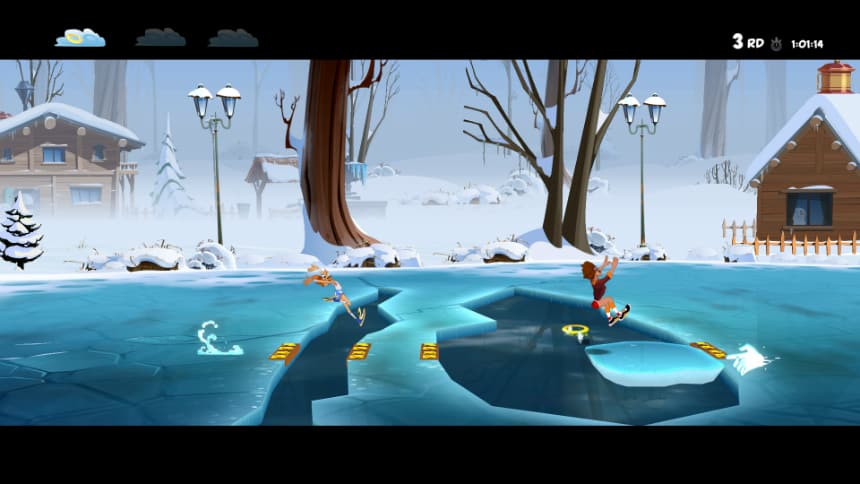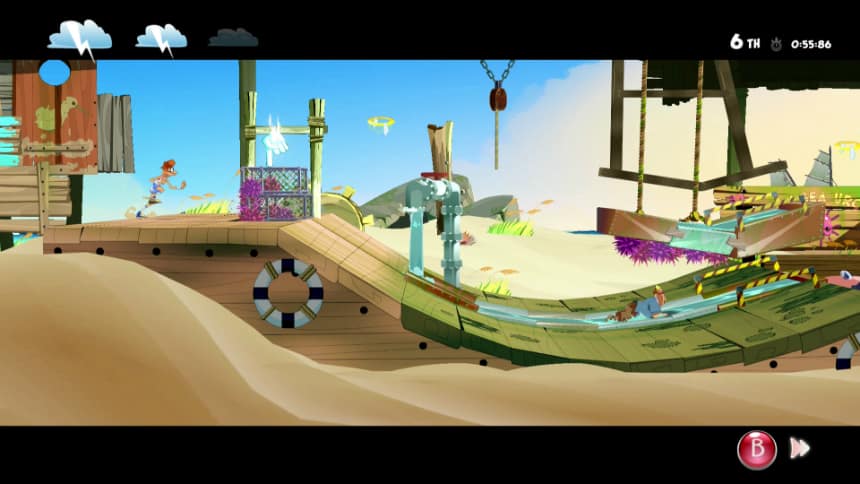It’s been a long time coming for Moon Spider Studios and their puzzle racing game Harold. First appearing back in 2012 with its vibrant Saturday morning cartoon-inspired graphics and fast-paced puzzle solving, the game seemingly disappeared only to re-emerge late last year and finally get a launch date of February 12th on Steam. Was it worth the wait? Read on for our Harold review to find out.
Gameplay
Where to begin in Harold. At its heart, the game is pegged as a racer, but that’s hardly the case. On the surface you are racing, sure, but in reality what you do along the path to pass other racers is solve puzzles quickly on the fly. To start every race, Harold invariably does something stupid or messes something up that causes him to start behind the pack by several yards. Game mechanics wise, this is to set you up in an F-Zero type situation where you are constantly chasing down other racers.

You don’t actually play as Harold himself, however. Instead you are a guardian angel tasked with protecting Howard and helping him win races so you yourself can win a scholarship to Archangel Academy. Being a merciful guardian angel, you have the ability to zap Harold and give him a speed boost. Collecting rings scattered throughout the tracks and hindering your opponents both grant you this ability (called a “puff power”) and also serve as an extra life for Harold should you fail to complete a puzzle in time and fall into a spike pit. If you’re inexperienced, it makes you strike a balance between boosting as much as possible, and keeping one puff power on hand in case you bite the dust on a difficult section of the track. Run out of puff power and you fail the race.
In order to catch those other racers you need to solve puzzles in each small quadrant of the race. This is accomplished using the same basic mechanics: jump, push, pull, turn, cut, hit, and lift. Each of these are used throughout the race first and foremost to get Harold over obstacles scattered throughout the courses. Platforms will need to be moved and lifted, ropes will need to be cut in order to make a route slippery so Harold speeds up, and handles need to be turned to lower bridges lest your racer smacks face-first into it. It sounds easy on the surface, but performing two and three of these in the few seconds that Harold is on any given screen gets extremely hectic, especially when the other elements of the race come into play.
Those same abilities that you use to aid Harold are also used to disrupt the other five runners. If you pull a platform out while another running is about to go over it, they’ll fall to their death and you’ll be granted another ring to charge your puff power. This brings to the forefront the challenge of having to balance taking out your opponents and keeping your own Harold alive. If you’re just playing to get through the races, or find something to be extremely hard, you can mostly skip these disruption techniques. On the other hand, if you’re going for high scores or to win every race, it’s going to become essential to master each of these techniques and flip between screens to do so.
Flipping back and forth between sections of the race is an ability you gain rather quickly. It’s one that – if you hope to master the game – you’ll have to learn to use effectively. For those keeping track at home, you now have to balance Harold avoiding traps, keep Harold’s speed boosted, take out opponents, and do all this between several screens at once. Like previously stated, it becomes extremely hectic and downright challenging. Throughout your dozens (if not more) failures in any given race you definitely start to feel it when everything begins to click. Guiding Harold through several sections of a track flawlessly, while also taking out your opponents and constantly boosting your own racer, is a feeling of satisfaction I haven’t felt in mainstream big budget games in a long time. It’s that release of dopamine you get from solving a difficult puzzle combined with the satisfaction of doing it all in an almost musical rhythm.
Just mastering the mechanics within the race isn’t enough to get a perfect time and win, however. Before you unlock each race, the course is broken up in 10-15 mini practice sessions. Each of these practice stages places three stars along the optimal path for that particular segment of the track. If you consistently are able to get three stars in a segment, you’ll likely be ready for that part in the real race. This serves several great purposes. For one, it allows you to practice a tricky section of a race near the end, so you’re not playing through the entire race only to lose in the last stretch several times over. Instead, you can go into practice and just bang out that one section until you have it down then plug it into your strategy to try and get the best time. Collecting every star in the practice mode will also give you another puff power slot to use in the race – another thing you’ll need for a perfect time.
Similar to disruptions and finding an optimal path, gathering the stars is mostly optional and only useful if you plan on trying for high scores or to actually win races instead of just coming in the required third place finish.
While the basic mechanics of the races (using abilities to aid Harold and hinder opponents) don’t change much throughout the game’s various courses, how they are used is extremely varied in each level. Sometimes moving one platform left will also move another up, down, or right; it really tests your dexterity and hand-eye coordination. More than once I was tied up during a race because I forgot which way a platform moved in the heat of the moment. With that said though, I can think of very few slip ups where it felt like the game was at fault and it was not just an error on my part. Even during the 20th attempt at the same spot in a track it never gets frustrating.
Also hidden within each track are two secret paths. They are extraordinarily hard to find, and I only found one serendipitously. I did find a few others, but only while purposefully hitting everything and falling into every trap-looking area I could find until I hit one. Each secret path has its own creative cutscene to go with it as well, such as Harold being frozen then thrown by a polar bear to the far end of the track, or other bizarre situations.

The only real issue is telling where Harold’s hit box is precisely. Animation in the game is absolutely gorgeous (more on that later) but with all the flailing body parts and burning feet spinning during a boost, it can be hard to tell when to jump exactly from a platform. Some platforms will have parts jutting out that look otherwise harmless but will often come back to bite you. One too many times Harold will fall from a platform when it looks like he should have another 2-3 steps left before he needs to jump. No matter how many hours I played (and it’s been quite a few) I never got over this little hiccup, it’s just always a little bit off.
All of this is tied together using an extremely intuitive control scheme that manages to get the most out of your controller (mouse and keyboard play is unavailable). Every trap can easily be controlled with the joystick, switching between them is done with the shoulder buttons, and lighting a fire under Harold to speed him up is done by pressing both bumper buttons simultaneously. Some kind of customization would have been nice, but the way everything is laid out was more than adequate for me.
Graphics
Simply put, Harold is absolutely gorgeous. It’s modeled after, as the developer puts it, “Saturday morning cartoons,” and it nails the look perfectly. It also looks heavily inspired by ’90s Disney films such as Aladdin and Hercules. Every character, background image, or object you interact with is beautifully animated. Colors are vibrant, and it’s almost always easy to tell at a quick glance what the objects you can interact with are. I say almost always, because there are times that they may blend in, but after running through a track more than once you quickly notice the objects that had you hung up on last time.

In between races, cutscenes are a simple style with mostly 2D images sliding around interacting with each other. Even then, everything is handled with such care and given such a personality that it still works. Seeing the fully-animated intros to each race are always visually interesting, and usually consist of Harold doing things like kicking a coconut that turns out to be a crab, getting a brainfreeze, or using the bathroom at the wrong time. Whatever it takes for him to start an extra 3-4 seconds late will be done.
Story
Harold’s story is extremely simple, but very effective. In a nice little twist on common stories, you play as Gabe – the cocky, overly talented guardian angel who has never had to try a day in his life during his time at angel school. One of the angels competing against you is the character who would be the main character in most other games. Seraphiel is the underdog that is looked down on by her family and constantly one-upped by Gabe.
The head of the guardian angels’ school holds a raffle of sorts where each guardian is given a racer that they have to guide to test their powers. Sadly for our douchey hero, Gabe, he gets stuck with the bumbling Harold. This gives the game a reason to have you be controlling such a slow and otherwise useless character in each race, and start so far behind as he fumbles at the beginning of each event.
Being that Gabe is such a great guardian angel, he only needs to get third in order to advance in his quest for that scholarship. It may seem like a small thing, but not having to win every race comes in huge later when some tracks are damn near impossible without mastering every single aspect of the game.
Sound
The music in Harold is another aspect where the game absolutely shines. Songs were created with a 30-person choir, and it shows. Each tune sounds like an epic piece from a big-budget cartoon, and they somehow never feel repetitive in the way. Often times in a game that requires as much failure such as Harold, I’ll get frustrated and end up annoyed at the soundtrack for playing the same song while I fall in a hole 15 times in a row, but that never happens here.
It’s also a nice touch how the choir interacts with the game. When you fall into a hole, the music will stop and the group will gasp, then resume singing once Harold is poof’d back into existence. In the same vein, when you pass another racer or enter a particular exciting part of the track, the choir will begin to cheer. All of this is yet another aspect of Harold that jams an extraordinary amount of personality into a simple little puzzle racer.
Sound design is ok, but mostly forgettable. I had to go back and purposefully find some things to interact with to even remember what they sounded like, but it’s mostly what sound like stock sound effects.
Voice acting is limited, but what is there is generally enjoyable. The main narrator for the sparse cutscenes is some kind of mix between a Saturday morning cartoon DJ and an excitable gameshow announcer; it fits perfectly. There are also some brief moments during tutorials or certain cutscenes where other angels will talk and their voices weren’t grating at the very least, which is more than you can ask out of a lot of indie-developed games.
Concept
Part racer, part puzzler, and part Saturday morning cartoon, Harold is a game chock full of original ideas and concepts. Everything that happens in the game has a simple story element to explain it, and the actual design of the individual tracks and obstacles you have to overcome are extremely well-done. In an age where it seems like big AAA games are all shooters and all indie games are pixel art platformers, Harold is a refreshingly unique concept both visually and in its core game design.
[button type=”link” link=”http://store.steampowered.com/app/338890/” variation=”btn-danger” target=”blank”]Purchase Harold on Steam[/button]
We were given a copy of Harold for the purposes of this review.
Last Updated on November 27, 2018.










Comments are closed.